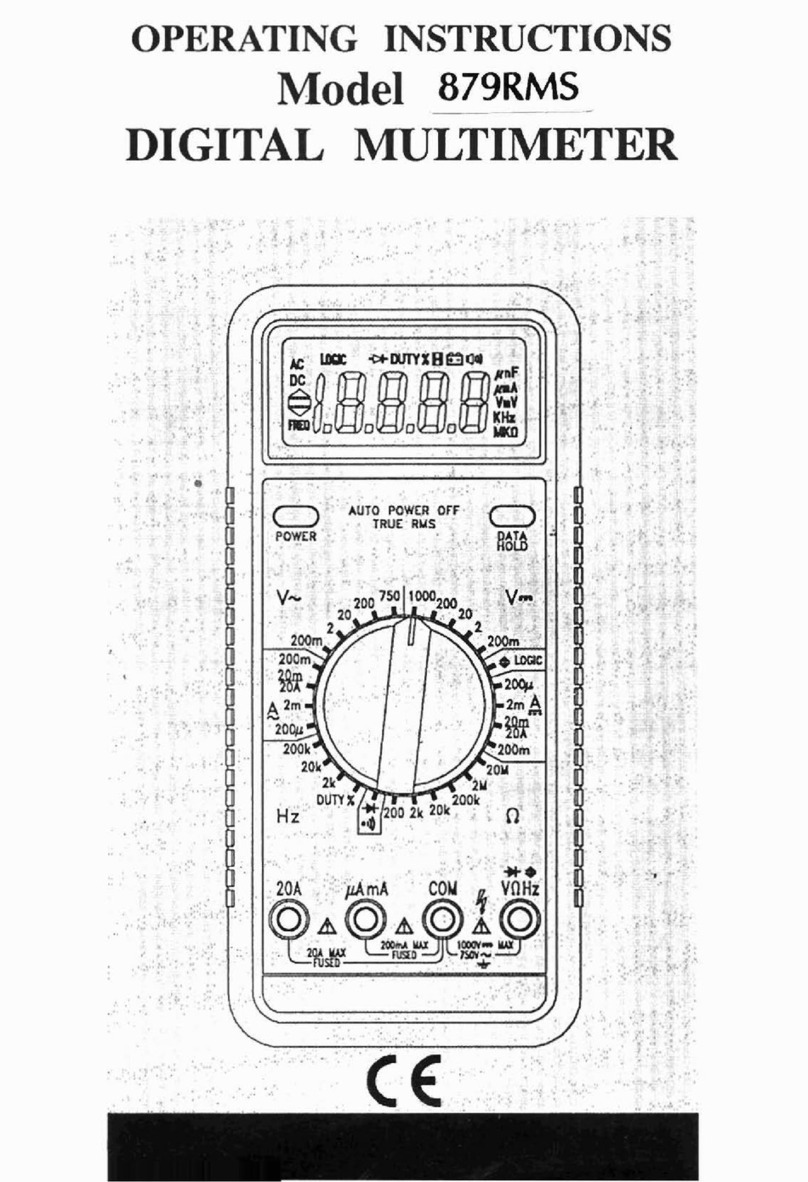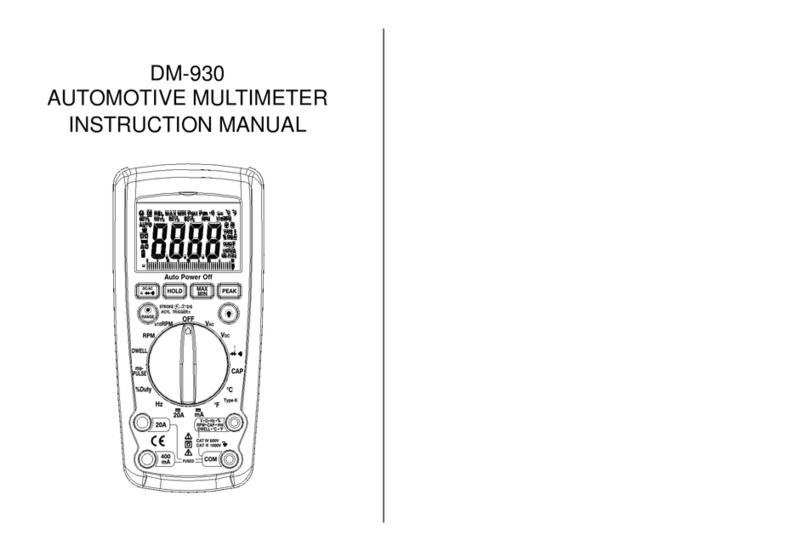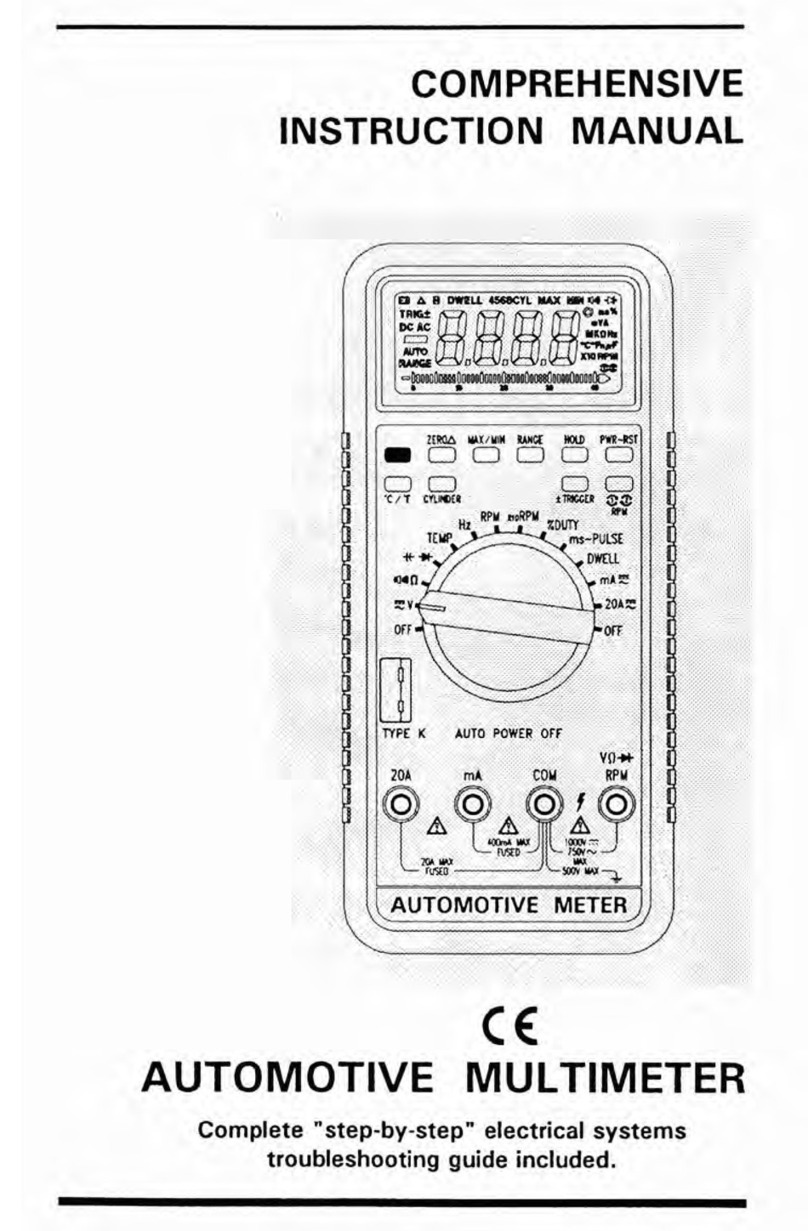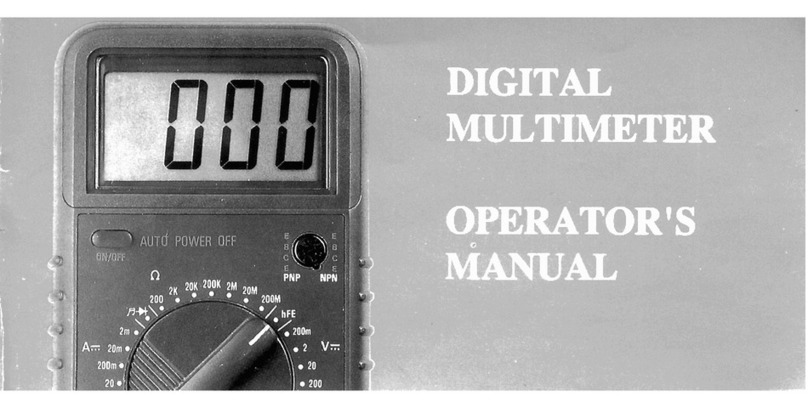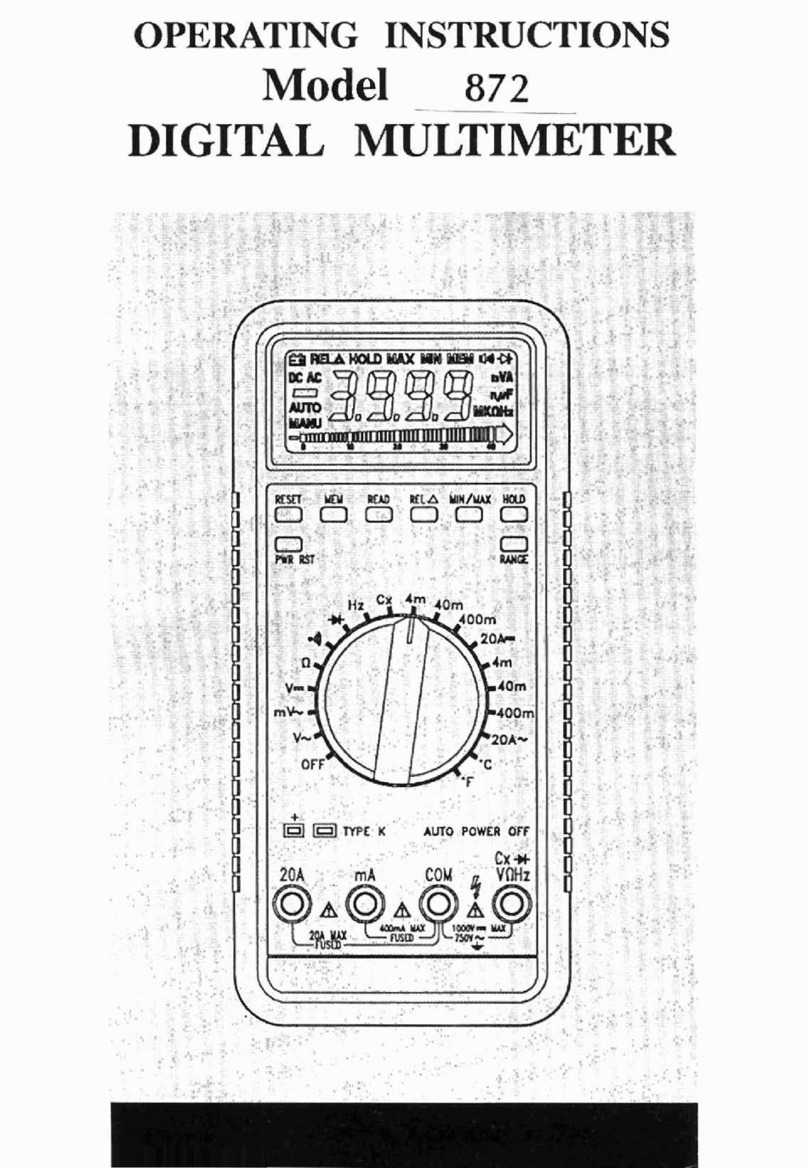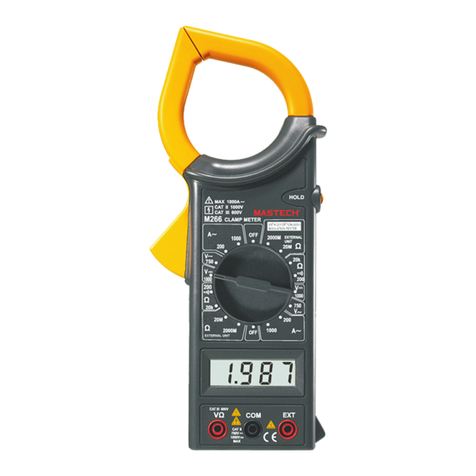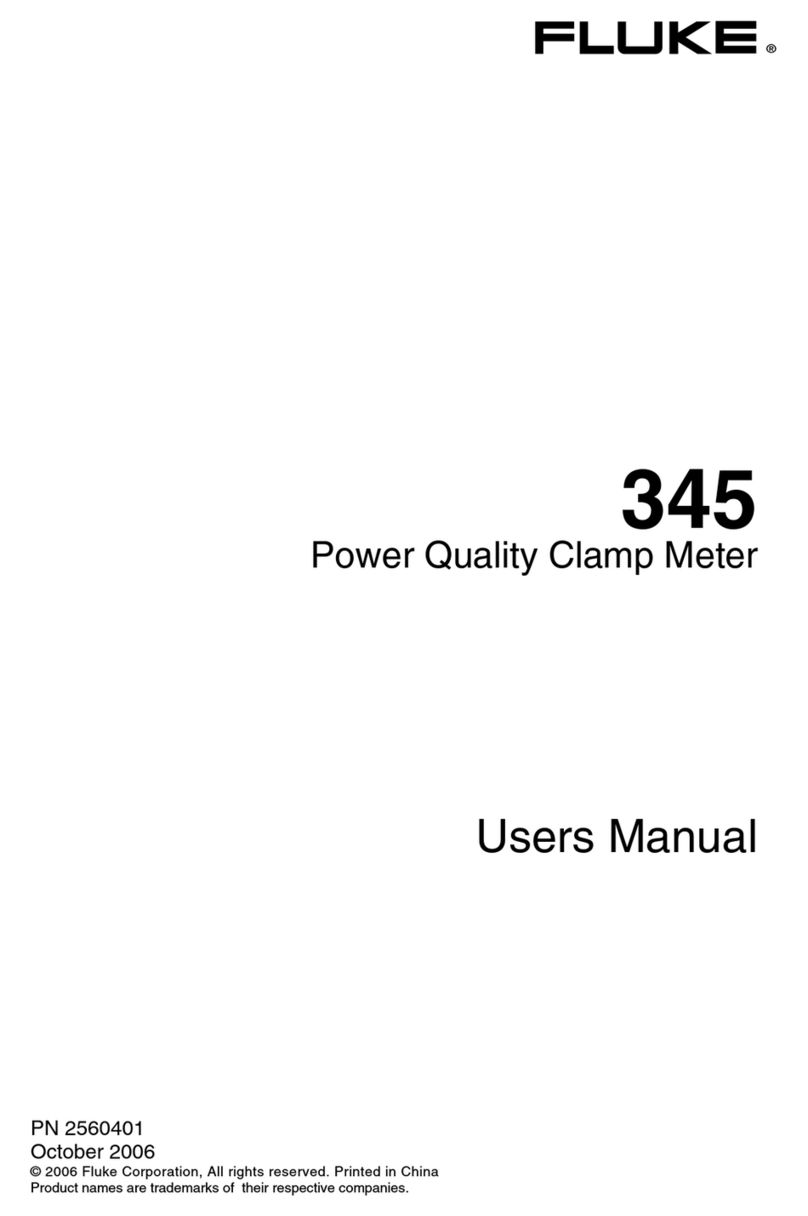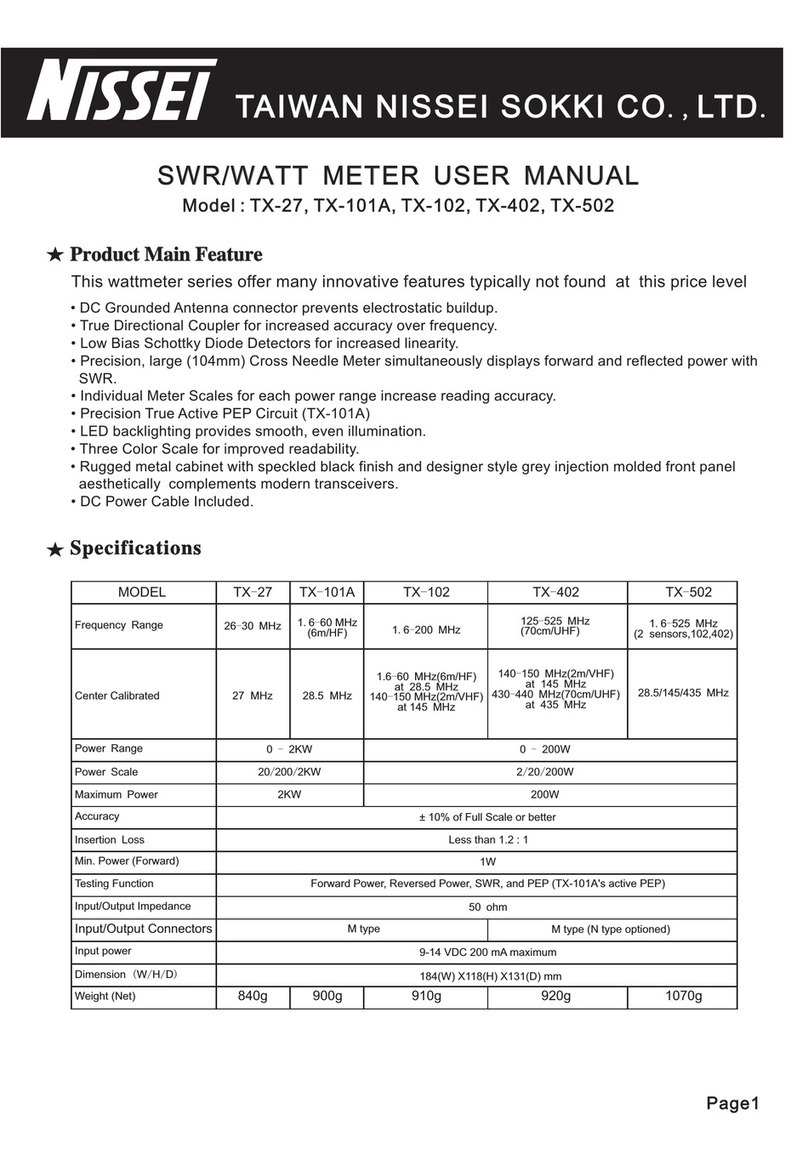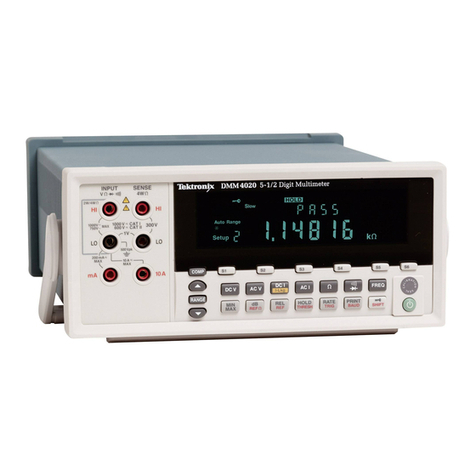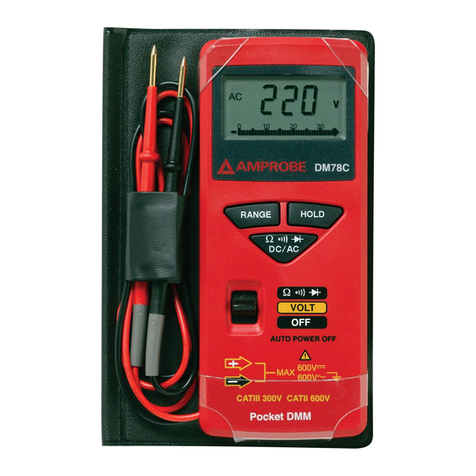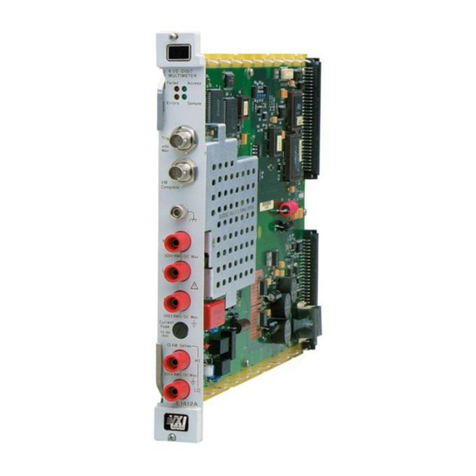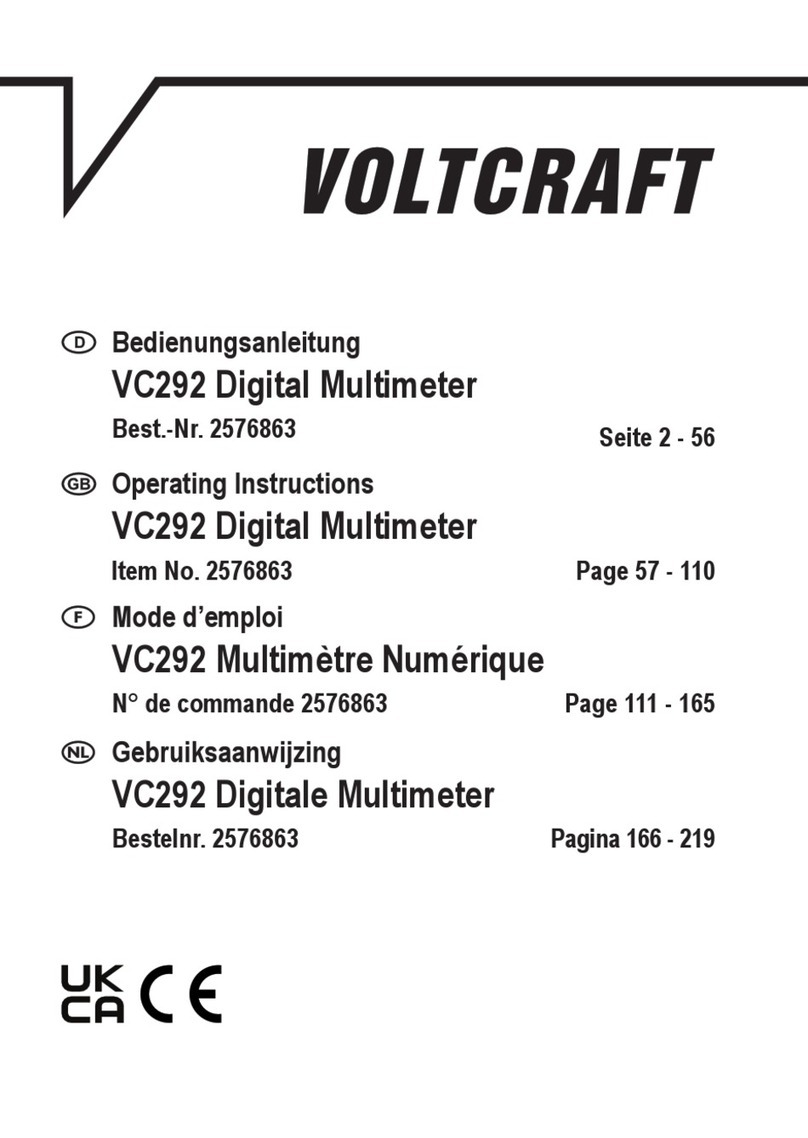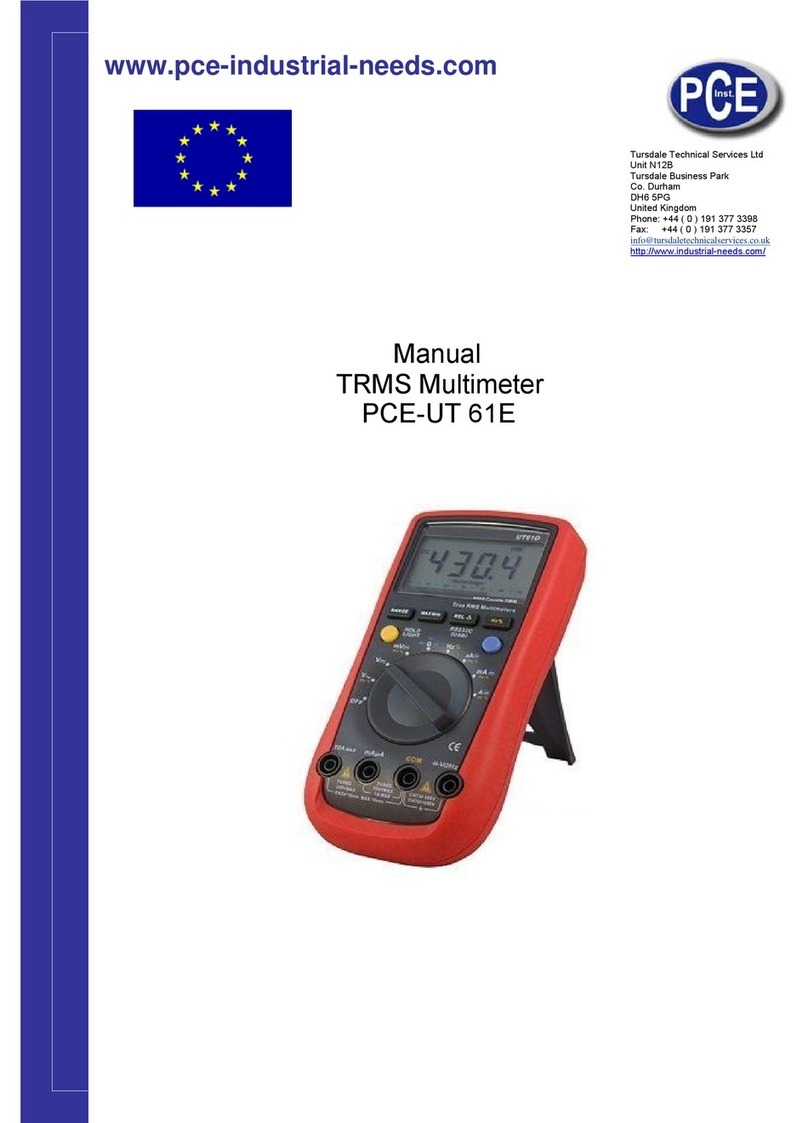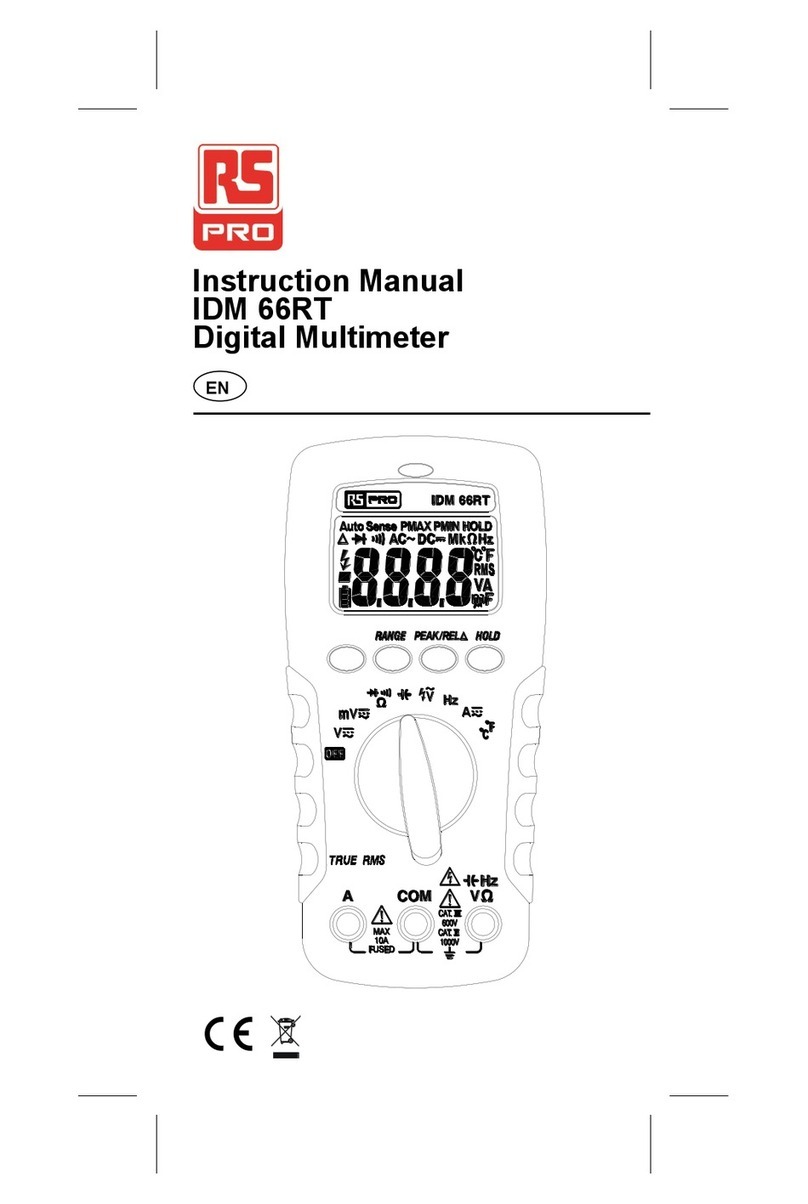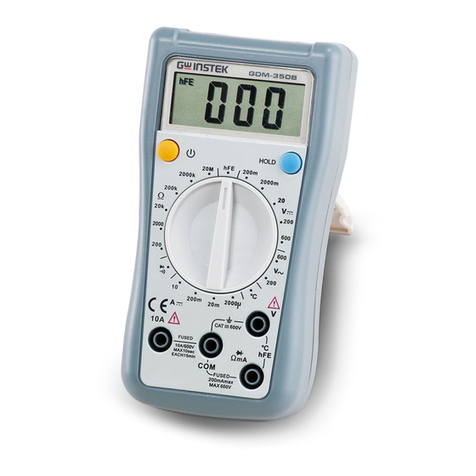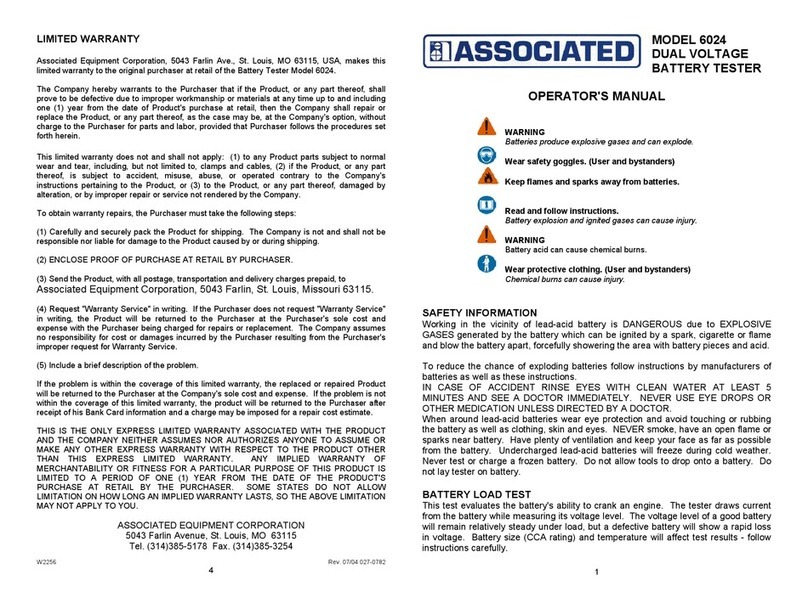PDi DM68 User manual

HANDHELD
DIGITALMULTMETER
OPERATOR'S
INSTRUCTION MANUAL

Table
of
Contents
TlTL
E
PAGE
1.
GENERALINSTRUCTIONS
1
1.1
Precautionsafety measures
1.1 .I
Preliminary
1.1.2
Duringuse
1.1.3
Symbols
1.1.4
Instructions
2.
DESCRIPTION
6
2.1
Instrument Familiarization
2.2
LCDDisplay
2.3
Key pad
2.4
Rotaryswitch
2.5
Terminals
2.6
Accessories
11
3.
FUNCTIONDESCRIPTION
12
3.1
General Functions
12
3.1
.I
DATA HOLDmode
12
3.1.2
Manual rangingandAutorange mode
12
3.1.3
Battery saver
13
3.2
MeasurementFunctions
3.2.1
AC and DC Voltage measurement
I
3.2.2
Resistancemeasurement
3.2.3
DiodeTest
3.2.4
ContinuityCheck
3.2.5
Capacitancemeasurement
3.2.6
Frequencymeasurement
3.2.7
Transistor measurement
3.2.8
Current measurement(withclamp,optional)
19
3.2.9
Current measurement
20

Tableof Contents
4.
TECHNICALSPECIFICATIONS
4.1 Generalspecifications..
4.2 Measurementspecifications
4.2.1 DC Voltage
4.2.2 AC Voltage
4.2.3 Resistance
4.2.4 DiodeTest
4.2.5 Continuity Check
4.2.6 Transistor
4.2.7 Capacitance
4.2.8 Frequency
4.2.9 Current (withclamp. optional)
4.2.10 DC Current
4.2.11 AC Current
5.
MAINTENANCE
5.1 Generalmaintenance
5.2 Batteryandfuse replacement
6.
HOW
TO USETHE HOLSTER
PAGE
21
21
22
22
22
23
23
23
23
24
24
24
.25
25
1. GENERALINSTRUCTIONS
This instrument complies with IEC 1010-1 (61010-l@IEC:
2001), CAT. II 1000Vand CAT. Ill600V overvoltage standards.
SeeSpecifications.
To get the best service fromthis instrument,readcarefullythis
user'smanualand respect the detailedsafety precautions.
Internationalsymbols used on the Meter and in this manual
I
are explainedin chapter 1
.I
.3
1
.I
Precautions safety measures
1.1.1
Preliminary
Measurementcategory Illisfor.measurements performedin
the buildinginstallation.
NOTE: Examplesare measurementson distributionboards,
circuit-breakers,wiring, includingcables, bus-bars,junction
boxes, switches, socket-outletsin the fixed installation,and
equipment for industrialuse and some other equipment, for
example, stationary motors with permanent connection to
thefixed installation.
Measurementcategory IIisfor measurementsperformedon
circuitsdirectlyconnected to the low voltageinstallation.
NOTE: Examples are measurements on household
appliances, portabletools and similarequipment.
*
Measurementcategory I isfor measurements performed on
circuitsnot directlyconnected to MAINS.
NOTE: Examplesare measurementson circuitsnot derived
from MAINS, and specially protected (internal) MAINS
derived circuits. In the latter case, transient stresses are
variable; for that reason, requires that the transient
withstand capabilityof the equipment is made known to the
user.

'
When using this Multimeter, the user must observe all
normalsafety rules concerning:
-
protectionagainst the dangersof electric current.
-
protectionof the Multimeteragainst misuse.
For your own safety, only use the test probes suppliedwith
the instrument. Before use, check that they are in good
condition.
1.1.2
Duringuse
If the meter is used near noise generating equipment, be
aware that display may become unstable or indicatelarge
errors.
'
Donot usethe meteror test leadsif they look damaged.
Use the meter only as specified in this manual; otherwise,
the protectionprovidedby the meter maybe impaired.
Use extreme cautionwhen working around bareconductors
or bus bars.
*
Do
notoperate the meter aroundexplosivegas, vapor, or dust.
Verify a Meter's operation by measuring a known voltage.
Do not use the Meter if it operatesabnormally. Protection
may be impaired. When indoubt, havethe Meter serviced.
Uses the proper terminals, function, and range for your
measurements.
When the range of the value to be measured is unknown,
check that the range initially set on the multimeter is the
highest possible or, wherever possible, choose the
autorangingmode.
'
To avoid damages to the instrument, do not exceed the
maximumlimits of the input values shown in the technical
specificationtables.
"
When the multimeter is linked to measurement circuits, do
not touch unusedterminals.
2
Cautionwhen working with voltages above 6OVdc or 3OVac
rms. Suchvoltages poseashock hazard.
When using the probes, keep your fingers behindthe finger
guards.
When makingconnections, connect the common test lead
before connecting the live test lead; when disconnecting,
.
I
disconnect the live test lead before disconnecting the
commontest lead.
Before changing functions, disconnect the test leads from
f
the circuit undertest.
For all dc functions, including manual or auto-ranging, to
avoid the risk of shock due to possible improper reading,
verify the presence of any ac voltages by first usingthe ac
function. Thenselecta dc voltage range equal to or greater
than the ac range.
Beforeattemptingto insert transistorsfor testing. always be
sure that test leads have been disconnected from any
measurementcircuits.
.
'
Components should not be connected to the hFE socket
when makingvoltage measurementswith test leads.
Disconnect circuits power and discharge all high-voltage
capacitors before testing resistance, continuity, diodes, or
capacitance.
Never perform resistance or continuity measurements on
livecircuits.
Before measuring current, check the meter's fuse and turn
off power to the circuit before connecting the meter to the
circuit.
*
In
N
repair work, or when carrying out measurements on
power switching circuits, remember that high amplitude
voltage pulsesat the test pointscan damagethe multimeter.
Useof a
TV
filter will attenuate any such pulses.
3

*
Use the
9V
NEDA battery, properly installed in the Meter's
battery case, to powerthe Meter.
Replacethe battery as soonas the batteryindicator
(
a
)
appears.With a low battery, the Meter might producefalse
readingsthat can leadto electricshock and personalinjury.
Do not measure voltages above
600V
in Categoly
Ill,
or
lOOOV
inCategory
I1
installations.
Do not operate the Meter with the case (or part of the case)
removed.
1.1.3
Symbols:
Symbolsusedinthis manualand on the instrument:
Caution:
referto the instructionmanual. Incorrect
use may result in damage to the device or its
components.
Dangerousvoltage may be present.
w
AC (AlternatingCurrent)
-
-
-
-
DC (DirectCurrent)
&
Earthground
Double insulated
8
Fuse
C
<
Conforms to European Uniondirectives
1.1.4
Instructions
Removetest leads from the Meter beforeopeningthe Meter
caseor battery cover.
'
When sewicing the Meter, use only specified replacement
parts.
"
Before opening up the instrument, always disconnect from
5
all sources of electric current and make sure you are not
charged with static electricity, which may destroy internal
components.
Any adjustment, maintenance or repair work carried out on
the meter while it is live should be carried out only by
appropriately qualified personnel, after having taken into
account the instructionsinthis present manual.
'
A "qualified person" is someone who is familiar with the
installation, construction and operation of the equipment
and the hazards involved. He is trained and authorized to
energize and de-energize circuits and equipment in
accordance with establishedpractices.
'
When the instrument is opened up, remember that some
internal capacitors can retain a dangerous potential even
after the instrument isswitchedoff.
*
If any faults or abnormalities are observed, take the
instrument out of serviceand ensurethat it cannot be used
untilit hasbeencheckedout.
*
If the meter is not going to beusedfor a longtime,take out
thebatteryand do notstorethe meter inhightemperature or
highhumidity environment.

2.
DESCRIPTION
2.1
Instrument Familiarization
a
RangeControlButton
Q
Data HoldButton
@
ACIDC Currentor
'I))/*
SelectingButton
@
Socket for TransistorTest
@
FunctionSwitcWPower Switch
@
V/n/F/Cx
lnputJack
COM lnputJack
@
m~/* lnputJack
@
10A
lnputJack
2.2
LCD
Display
SeeTable
1
indicatedfor informationabout the LCDdisplay.
Indicatorfor ac voltage or current.
AC voltage and current are displayed as the
average of the absolute value of the input.
calibratedto indicatetheequivalentrmsvalue
of a sine wave.
---
Indicatorfor dc voltageor current.
Table
1.
DisplaySymbols
Symbol Meaning
The batteryislow.
Warning: To avoidfake readings, which
wuld lead to possible electric shock or
personalinjury, replacethe batteryas soon as
thebafferyindicatorappears.
Indicatesnegativereadings.
AUTO
The Meter is in the Autorangemode in which
themeterautomaticallyselectsthe rangewith
the bestresolution.

Symbol
-H
Hz,
kHz, MHz
le
1.
Display Symbols(continued)
Meaning
Indicatorfor the DiodeTest mode
lndicatorfor the transistortest mode
lndicatorfor the ContinuityCheck mode.
lndicatorfor the Data Hold mode
V:
Volts. The unit of voltage.
mV: Millivolt. 1x10~~or 0.001 volts.
A: Amperes (amps).The unitof current.
mA: Milliamp. 1x10.~or 0.001 amperes.
pA:
Microamp. 1x10.~ or 0.000001
amperes
R: Ohm. The unitof resistance.
kR: Kilohm.1x10~or 1000ohms.
MR: Megohm. 1x10~or 1,000,000 ohms.
Hz: Hertz. The unit of frequency in
cycleslsecond.
KHz: Kilohertz.lxlo3or 1000hertz.
MHz: Megahertz. 1x10~or 1,000,000 hertz
F:
Farad.The unit of capacitance.
vF: ~icrofarad.1~10-6or 0.000001
farads.
t
nF:
Nanofarad. 1x10'' or 0.000000001
farads.
The input is too large for the selected
ranae.
2.3
Keypad
See Table
2
indicated for information about the keypad
operations.
Switches betweenDiode
Test andContinuity check.
ac current.
Power-up
Option
Disablesautomatic
power-offfeature.
I
DATA-H Any
switch
position
RANGE
V-,
V=,
R,
*,
mAand
pA.
PressHOLDto enterand
exit the Data Holdmode.
1.
PressRANGEto enter
the manual ranging
mode.
2.
Press RANGE to step
through the ranges
available for the
selectedfunction.
3.
Pressand hold RANGE
for
2
seconds to returnto
autoranging.

2.4
Rotaryswltch
See Table
3
indicatedfor informationabout the rotary switch
positions. Table
3.
RotamSwitch Positions
I
Hz
I
Frequency measurement
I
Switch Position
V-
v=
n
-bt
-lo
Cap
I
hFE
I
Transistormeasurement
I
Function
AC Voltage measurement
DC Voltage measurement
Resistancemeasurement
DiodeTest
I
ContinuityCheck
Capacitance measurement
Measurement with clamp (optional),
widening the field of applications of
the multimeter
DC or AC current measurements
I
from0.1 pAto 4000pA.
I
m
A DC or AC current measurements
from 0.01mA to 400mA.
2.6
Accessories
Delivered
withthe multimeter:
User's manual
'
Test leads
Holster
2.5
Terminals
SeeTable
4
indicatedfor informationabout the terminals.
Table
4.
Terminals
I
A
I
DCor AC Currentmeasurementfrom
I
+
J
Optional:
Clamp
Terminal
COM
VnFCx
rn~s
A
Description
Return terminal for all measurements.
(Receiving the black test lead or the "comn
plugof the optionalclamp)
lnputfor voltage, resistance, frequency,
Capacitance, diode and continuity
measurements. (Receivingthe redtest lead)
lnput for 0.1pA to 400mA current
measurements. (Receivingthe redtest leador
the
"+"
plugof the optionalclamp)
lnputfor 400mA to 10Acurrent measurements.
(Receivingthe redtest lead)

3.
FUNCTIONDESCRIPTION
3.1
GeneralFunctions
3.1.1
DATA HOLDmode
Data Holdmodemakesthe meter stop updatingthe display.
Enabling Data Holdfunction inautorange modemakes the
meter switch to Manual ranging mode, but the full-scale
range remains the same. Data Hold function can be
cancelled by changing the measurement mode, pressing
RANGEkey, or push HOLD key again.
To enter and exit the DataHoldmode:
1. PressHOLDkey (short press). Fixesthe displayon the
currentvalue, "H"" isdisplayed.
2.
Asecond short press returnsthe meterto normalmode.
3.1.2
Manualranging andAutorange mode
The Meter has both manual ranging and autorange
options.
Inthe autorangemode, the Meter selects the best range
for the input detected. This allows you to switch test
pointswithout havingto reset the range.
Inthe manual ranging mode, you select the range. This
allows you to overrideautorangeand lockthe meter ina
specific range.
The Meter defaults to the autorange mode in
measurementfunctions!hat have more than one range.
When the Meter is in the autorange mode, AUTO is
displayed.
To enter and exit the manualrange mode:
1.
Press RANGE key. The Meter enters the manual
rangingmode.AUTO turnsoff. Eachpresses of RANGE
key increments the range. When the highest range is
reached,the Meter wraps to the lowest range.
12
NOTE: If you manually change the measurement range afier
entering the Data Hold modes, the Meter exits this
mode.
2.
To exit the manual ranging mode, press and hold down
RANGE key for two seconds. The Meter returns to the
autorange mode and AUTO isdisplayed.
3.1.3
Battery Saver
I
The Meter enters the "sleepmode" and blanksthe display
ifthe Nleter is on but not used for 30 minutes.
Pressthe HOLDkeyor rotatethe rotaryswitchto wake the
meter up.
iI,./*
To disable the Sleep mode, hold down the
4-
key
while turning the meteron.
3.2
MeasurementFunctions
3.2.1
AC and DCVoltage measurement
I
A
To avoid electricalshock andor damage to the
I
instrument, do not attempt to take any voltage
measurement that might exceed lWOVdc or
75OVac rms.
To avoid electricalshock andor damage to the
instrument, do not apply more than lOOOVdc or
750Vac rms between the common terminal and
theearthground.
The polarity of ac (alternatingcurrent) voltage varies over
I
time; the polarityof dc (directcurrent) voltage isconstant.
The Meter's DC voltage ranges are 400.0mV. 4.000V.
40.00V, 400.OV and 1000V
:
AC voltage ranges are
400.0mV ,4.000V, 40.00V, 400.OV and750V.
(AC 400.0mV rangeonly existsinmanual rangingmode).

To measureac or dc voltage:
1.
Set rotaryswitchto the
DCV
orACV range.
2.
Connect the blackand redtest leadsto the COM and
Vterminalsrespectively.
3.
Connect thetest leadsto the circuit beingmeasured
4. Readthe displayedvalue. The polarityof red test lead
connection will be indicated when making a DCV
measurement.
NOTE:
Unstable display may occur especiallyat 400mV range,
eventhough you donot puttest leadsintoinputterminals,
inthis case, if an erroneous reading is suspected, short
the Vterminaland the COM terminal, and make surethe
zero display.
.
For better accuracy when measuringthe dc offset of an
ac voltage, measure the ac voltage first. Note the ac
voltage range, then manually select a dc voltage range
equal to or higher than the ac range. This improves the
accuracy of the dc measurement by ensuring that the
input protectioncircuitsare notactivated.
3.2.2
Resistancemeasurement
I
A
To avoid electrical shock andlor damage to the
I
I
Instrument, disconnect circuit power and
discharge all high-voltage
capacitors
before
I
measuring resistance.
The unit of resistance is the ohm (R). The Meter measures
resistance by sending a small current through the circuit.
Because this current flows through all possible paths
between the probes, an in-circuit resistance reading
represents the total resistance of all paths between the
The Meter's resistance ranges are 400.0R, 4.000kR,
40.00kR, 400.0kR, 4.000MR and40.00MR.
To measure resistance:
1.
Set the rotary switchto range.
2.
Connect the black and red test leadsto the COM and
R terminalsrespectively.
3.
Connect the test leads to the circuit being measured
and readthe displayedvalue.
-
I
Sometips for measuringresistance:
The measured value of a resistor in a circuit is often
diierent from the resistor's rated value. This is because
the Meter's test current flows through all possible paths
betweenthe probetips.
Inorder to ensurethe best accuracy inmeasurement of low
resistance, short the test leads before measurement and
memorythe test probe resistanceinmind.This necessaryto
subtractfor the resistance of thetest leads.
The resistance function can produce enough voltage to
forward-bias silicon diode or transistor junctions, causing
themto conduct. To avoidthis, do not usethe 40MR range
for in-circuitresistance measurements.
'.
On 40MR range, the meter may take a few seconds to
stabilize reading. This is normal for high resistance
measuring.
•
When the inputisnotconnected, i.e. at open circuit,the
figure "OL"will be displayedfor the overrange condition.
probes. 14

3.2.3
DiodeTest
A
To avoid electrical shock andor damage to the
instrument, disconnect circuit power and
discharge all high-voltage capacitors before
testingdiodes.
Use the diode test to check diodes, transistors, and other
semiconductor devices. The diode test sends a current
through the semiconductor junction, then measures the
voltage drop across the junction,
A
good silicon junction
drops between0.5V and 0.8V.
To test adiodeout of a circuit:
1.
Set the rotary switchto
4
range.
2.
Pressthe
04l-bk
keyto activate DiodeTest.
3.
Connect the black and red test leads to the COM and
VR terminalsrespectively.
4.
For forward-bias readings on any semiconductor
component, place the red test lead on the
component's anode and place the black test lead on
the component's cathode.
5. The meter will show the approx. forward voltage of the
diode.
In a circuit, a good diode should still produce a forward bias
reading
of
0.5V to 0.8V; however, the reverse-bias reading
can vary depending on the resistance of other pathways
between the probetips.
3.2.4
Continuity Check
A
To avoid electrical shock andor damage to the
instrument, disconnect circuit power and
discharge all high-voltage capacitors before
testing for Continuity.
Continuityis a complete pathfor current flow.
The beeper sounds if a circuit is complete. These brief
contactscause the Meterto emit a short beep.
To test for continuity:
1.
Set the rotary switchto
-bb
-0
range.
2.
Pressthe
*l)ll-bk
keyto activateContinuityCheck.
3.
Connect the black and red test leads to the COM and
Q
terminalsrespectively.
4.
Connect the test leads to the resistancein the circuit
beingmeasured.
5. When the test lead to the circuit is below 50R, a
continuousbeepingwill indicateit.
Note:
*
Continuity test is available to check openlshort of the
circuit.
3.2.5
Capacitancemeasurement
A
To avoid electrical shock andor damage to the
instrument, disconnect circuit power and
I
discharge all high-voltage capacitors before
measuring capacitance. Use the dc voltage
1
function to confirm that the capacitor is
(
I
discharged.
Capacitance is the ability of a component to store an
electricalcharge.
17

The unitof capacitance is the farad (F). Most capacitorsare
in the nanofaradto microfarad range. The Meter measures
capacitance by charging the capacitorwith a knowncurrent
for a known period of time, measuringthe resultingvoltage,
then calculating the capacitance. The measurement takes
about
1
secondper range.
The Meter's capacitance ranges are 4.000nF 40.00nF,
400.0nF, 4.0001F, 40.00pF and200.01F.
To measurecapacitance:
1.
Set the rotary switchto Cap range.
2. Connect the blackand red test leadsto the COM and Cx
terminalsrespectively.
3. Connect the test leads to the capacitor being measured
and readthe displayedvalue.
Sometipsfor measuring capacitance:
The meter may take a few seconds (200pF range. 30
seconds) to stabilize reading. This is normal for high
capacitancemeasuring.
To improvethe accuracy of measurements lessthan 4nF,
subtract the residualcapacitance of the Meterand leads.
3.2.6
Frequency measurement
A
Do not measure Frequency on hlgh voltage
(>250V) to avoid electrical shock hazard andor
I
damageto the instrument.
1.
Set the rotaryswitchto
Hz
range.
2. Connect the black and red test leads to the COM and Hz
terminalsrespectively.
3. Connect the test leads across the source or load under
measurement, and readthe displayedvalue.
Note:
3.2.7
Transistor measurement
instrument, before attempting to Insert
transistors for testing, always
be
sure that test
leads have been disconnected from any
measurementcircuits.
1.
Set the rotaryswitch to hFE range.
2.
Determine whether the transistor to be tested is NPN or
PNPtype and locatethe Emitter,Base andCollectorleads.
3.
Insert leads of the transistor into proper holes of the hFE
socket.
4. The meterwill show the approx. hFE value at testcondition
of basecurrent 10vAand Vce 2.8V.
3.2.8
Current measurement(with clamp, optional)
A
To avoid electrical shock and/or damage to the
Instrument, do not apply more than 250Vdc or
250Vac nns between the
m
terminal and the
COMterminal.
1
1.
Setthe rotary switch to the
m
range.
2. Press
=J-
keyto select DCA or ACA measuringmode.
3.
Connect the leads of the clamp to the COM and
terminalsof the meter.
4. Read the displayedvalue. The polarity of the
VQ
terminal
connection will be indicated when making a DCA
measurement.
5.
When only thefigure
"OL
"
displayed, it indicatesoverrange
situation.
Innoisyenvironment, it is preferableto use shieldcablefor
measuringsmallsignal. 18

3.2.9
Current measurement
I
To avoid damage to the Meter or injury if the
I
I
fuse blows, never attempt an in-circuit current
measurement where the open-circuit potential
I
I
to earth is greater than
250K
Toavoid damage to the meter,check the meter's
I
fuse before proceeding. Use the proper
terminals, function, and range for your
measurement.Never place theprobes inparallel
with a circuit or component when the leads are
The Meter's current ranges are 400.OpA, 4000p4,
40.00mA, 400.0mA, and 10.00A.
To measurecurrent:
1. Turn off power to the circuit. Discharge all high voltage
capacitors.
2. Set the rotary switchto the
pA,
mA or A range.
3. Press the
=J-
key to select DCA or ACA measuring
mode.
4. Connectthe black test leadto the COMterminalandthe
red test leads to the mA terminal for a maximum of
400mA. For a maximumof 1OA, move the redtest lead
to theAterminal.
5. Break the circuit path to betested.
Touch the black probeto the more negativeside of the
break; touch the red probe to the more positive side of
the break. (Reversing the leads will give a negative
reading, but will not damage the Meter.)
6. Turn on power to the circuit; then read the display. Be
sure to note the measurement units at the right side of
the display (FA, mA or A). When only the figure "OL"
displayed, it indicates overrange situation and the
higher rangehasto be selected.
20
7. Turn off power to the circuit and dischargeall high voltage
capacitors. Remove the Meter and restore the circuit to
normaloperation.
4
TECHNICALSPECIFICATIONS
4.1
GENERALSPECIFICATIONS
*
Environmentconditions:
IOOOV CAT.
I1
and 600V CAT.
Ill
Pollutiondegree: 2
Altitude
<
2000m
Operatingtemperature:
0-40"C,32°F-122'F (<80% RH, clO'C non-condensing)
Storagetemperature:
-1
0-60
"2,
14°F-140°F (<70%
RH,
battery removed)
'
TemperatureCoefficient:
0.1
specified
accuracy)
I
'C (<I8'C or >28%)
*
MAX.
Voltage betweenterminalsand ealth ground:
750VAC rms or 1000V DC.
*
Fuse Protection:
pA
and mA: F500mN250V 05x20;
1OA: F 10N250V06.3~32.
Sample Rate: 3 timeslsec for digitaldata.
'
Display:
3 314 digits LCD display. Automatic indication of functions
andsymbols.
Rangeselection:automatic and manual.
Over Rangeindication:LCD will display"OL".
Low battery indication:
The
"m"
is displayed when the battery is under the
properoperationrange.
Polarity indication:
"-"
displayedautomatically.
Power source: 9V
-
21

Batterytype: NEDA 1604,6F22,or 006P.
'
Dimensions:91(L)x189(W)x31,5(H) mm.
Weight: 3109. Approx. (batteryincluded).
4.2
Measurementspecifications
Accuracy is specified for one year after calibration, at
operatingtemperatures of 18'C to 28%, with relativehumidity
at 0% to 75%.
Accuracy specificationstake the form of:
+
(%
of Reading
+
Number of Least SignificantDigits)
O.lmV
i
(0.7%of rdg +2 digits)
400V
I
IOO~V
I
lOOOV
I
1V
I
i
(0.8% of rdg+2 digits)
Inputimpedance: IOMQ
Max. input voltage: lOOOVdc or 750V ac rms.
4.2.2
AC
Voltage
I
Range
1
Resolution
I
Accuracy
400mV
I
O.lmV
I
~(3.0%of rdg
+
3 digits)
400V
I
lOOmV
I
750V
I
1V
I
i
(
1.O% of rdg
+3
digits)
Input impedance: lOMR
Max. input voltage: 1000Vdcor 750V ac rms.
Frequency Range: 40Hz-200Hz for 4V range, 40Hz-1kHz for
other ranges.
Response:Average, calibratedin rms of sine wave
22
4.2.3
Resistance
4.2.4
Diode
I
Range
I
Resolution
I
Function
I
Range
400.0~
4.00om
40.OOkQ
400.0kQ
4.000MQ
40.00MR
4.2.5
~udiblecontinuity
Range
I
Continuity beeper
*,I)
1
S50Q
1
Opencircuitvoltage: approx.0.5V.
Overloadprotection: 250Vdc or 250Vac rms.
Overload protection: 250V dc or 15OVac rms.
OpenCircuitVoltage: approx. 250mV.
Resolution
0.10
IQ
1
OQ
1OOR
I
kR
1ok~
*
Accuracy
*
(
1.2%%of rdg
+2
digits)
i
(2.0% of rdg
+5
digits)
Display read approx.
ImV
I
forwardvoltage of diode
I
Forward DC Current: approx.
I
mA
ReversedDC Voltage: approx. 1.5V
Overload protection: 250Vdc or 150Vac ns.
4.2.6
Transistor
Range
hFE
Description
Display read approx. HFE
value (0-1000)of transistor
undertest (alltype).
Test Condition
BaseCurrent
approx. lOpA,
Vce approx. 2.8V.

400nF +(3.0%of rdg+3digits)
4.2.7
Capacitance
Overloadprotection: 250Vdc or 250Vac rms.
Range
4nF
40nF
4.2.8
Frequency
I
Range
I
Resolution
I
Accuracy
Resolution
I
pF
1OpF
4.2.9
Current (with clamp, optional)
-
Accuracy
i(5.0% of rdg+5digits)
9.999Hz
99.99Hz
999.9Hz
9.999kHz
99.99kHz
199.9kHz
>2OOkHz
Range
I
Resolution
1
Accuracy
DC40A
I
O.1NlmV
I
*(0.8% of rdg+3 digits)
Overloadprotection:250V dc or 250V ac rms.
lnput Voltage range: 0.6V-3V ac rms (Input voltage must be
enlarged with increasing frequency
under measurement)
FrequencyResponse: 1
OHzPOOkHz, sinewave.
0.5Hz-200kHz, square wave.
0.001 Hz
0.01 Hz
Hz
1Hz
lOHz
1OOHz
1OOHz
*(2.0% of rdg+5 digits)
Unspecified
@
>200kHz
DC400A
AC40A
AC400A
1-1
r(1.2%of rdg+3 digits)
1
0.01mA
4.2.10
DCCURRENT
10A
(
IOmA
1
42.0% of rdg+5 digits)
I
lnputimpedance: 1
MR
Max. input voltage: 250Vdc or 250Vac rms.
24
0.1
PJlmV
O.1NlmV
O.1AflmV
Overload protection: F 10PJ250V fuse for A range.
F
500mA1250V fuse for pA and mA
ranges.
Maximum input current: 400mA dc or 400mA ac rms for
pA
and mA ranges, 10A dc or 10A ac
Accuracy
Range
1
Resolution
i(0.8%of rdg+3digits)
i(l.O% of rdg+3 digits)
*(I .O% of rdg+3 digits)
rmsforA ranges.
For measurements>5A, 4 minutes maximum
ON
to measure
10minutes
OFF.
400pA 0.1@
4000pA
1-1
0.01mA +(I.5Y0 of rdg+5 digits)
4.2.11
AC CURRENT
400mA
I
O.lmA
I
10A
I
1OmA
1
i(3.0% of rdg+7digits)
Range
4ow
Overloadprotection: F 10N250Vfuse for A range.
F 500mN250V fuse for pA and mA
ranges.
Maximum input current: 400mA dc or 400mA
ac
rms for pA
and mA ranges, 10A dc or 10A ac
rmsforA ranges.
Frequency Range: 40Hz-1kHz
Response:Average, calibratedin rrns of sine wave
25
Resolution
0.1pA
Accuracy

5.
MAINTENANCE
This section provides basic maintenance information,
includingfuse and batteryreplacement instructions.
Do not attempt to repair or service your Meter unlessyouare
qualified to do so and have the relevant calibration,
performancetest, and sewiceinformation.
5.1
GeneralMaintenance
A
To avoid electrical shock or damage to the
meter, do not get water inside the case. Remove
the test leads and any input signals before
opening the case
Periodically wipe the case with a damp cloth and mild
detergent. Do not use abrasives or solvents.
Dirtor moistureinthe terminalscan affect readings.
To clean the terminals:
*
Turn the meter off and removealltest leads.
Shake out any dirt that may beinthe terminals.
Soak a new swab with a cleaningand oiling agent (suchas
WD-40).
*
Work the swab around in each terminal. The oiling agent
insulatesthe terminalsfrom moisture-relatedcontamination.
5.2 Battery and
fuse
replacement
If the sign "mwappearson the LCD display, it indicatesthat
the battery should be replaced. Remove screws on the back
cover and open the case. Replace the exhausted batterywith
a new one.
Fuse rarely need replacement and blow almost always as a
result of the operator's error .Open the case as mentioned
above, and then take the PCB assembly out from the
A
WARNING
Before attempting to open the case, be sure that test leads
have been disconnected from measurement circuits to avoid
electricshock hazard.
For protection against fire, replace fuse only with specified
ratings: F1: F5OOmA/250V F2: F lOA/ZSOV
6.
HOWTO USETHE HOLSTER
The holster is used to protectthe meter and to make the
measurement more comfortable. it comes with two stands
installedtogether. The following figure shows how to use the
holsterto:
a. Supportthe meter with a standard angle.
b. Support the meter with a small angle using the little
stand
c. Hang the meter on the wall using the little stand. Take
the little stand off from the backside of the large stand
and insertit intoholes locatedupper on the holster.
d. Holdtest leads.
CAUTION:
"Usingthis appliance in an environment with a strong radiated
radio-frequency electromagnetic field9approximately 3V/m),
may influence its measuring accuracy The measuring result
1
can be strongly deviatingfrom the actual value"
case .Replacethe blown fuse with ratingsspecified.
26

Table of contents
Other PDi Multimeter manuals

